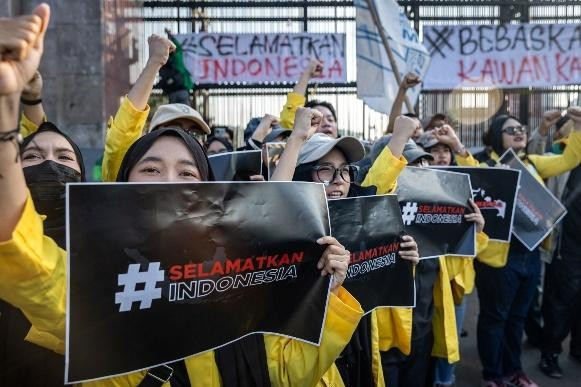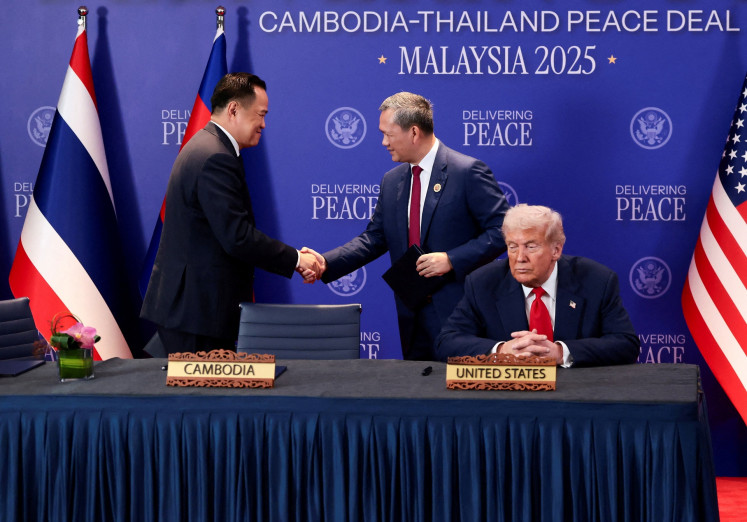Popular Reads
Top Results
Can't find what you're looking for?
View all search resultsPopular Reads
Top Results
Can't find what you're looking for?
View all search resultsUS trade war enters precarious slow grind
It may be less turbulent than this past spring's drama, but no less worrying for investors.
Change text size
Gift Premium Articles
to Anyone
 Steel coils are seen in a yard at ArcelorMittal Dofasco's steel mill on June 9, in Hamilton, Canada, after United States President Donald Trump signed an order to double tariffs on steel and aluminum imports from 25% to 50%, affecting top steel partners, including Canada, Brazil and Mexico. (AFP/Getty Images/Cole Burston)
Steel coils are seen in a yard at ArcelorMittal Dofasco's steel mill on June 9, in Hamilton, Canada, after United States President Donald Trump signed an order to double tariffs on steel and aluminum imports from 25% to 50%, affecting top steel partners, including Canada, Brazil and Mexico. (AFP/Getty Images/Cole Burston)
U
nited States trade negotiations have transitioned from their opening act, with its many twists and turns, into a new, protracted chapter: the Slow Grind. It may be less turbulent than this past spring's drama, but no less worrying for investors.
Now that the US and China have the framework for a trade agreement, attention may start to turn to the European Union, which appears next in line to strike a deal with the Trump administration. But the prospect of a swift resolution seems remote.
Finding significant common ground to meaningfully reduce the EU's substantial goods surplus with the US, roughly US$200 billion annually, presents a formidable challenge, as major avenues appear blocked.
First, the EU is highly unlikely to concede on agricultural market access given the region's strong and comprehensive policy for protecting local agriculture. Large-scale aircraft deals also seem improbable given the Airbus-Boeing rivalry. The contentious issue of pharmaceutical pricing will complicate any healthcare deals. And US automakers will likely struggle to make much of a dent in the EU market given entrenched European consumer preferences and regulatory hurdles.
While Europe could theoretically increase purchases of US defense equipment or relax "Buy European" policies in defense procurement, the political palatability of such moves is low.
Consequently, the focus may inevitably shift towards the services sector, where the EU runs an approximately $100 billion annual deficit with the US, driven largely by the operations of US technology giants.
Here, a potential landing zone exists: the EU could conceivably ease some of its more burdensome technology regulations with limited immediate downside, offering a tangible, albeit partial, lever to address the overall trade imbalance.
In fact, Section 899 in the Trump administration's proposed "One Big Beautiful Bill Act", which threatens to increase taxes on entities from countries with "unfair foreign taxes", appears to be aimed directly at digital taxes levied by EU countries on US technology companies.
US negotiations with the EU are also occurring against a markedly different backdrop than the one that prevailed in May during the earlier round of trade talks with China.
Back then, the US was just emerging from a significant bout of financial market volatility and facing the risk of "empty shelves" if onerous tariffs on China remained in place, so both investors and business leaders were demanding urgent action.
The US administration is now operating under fewer acute time constraints. Importantly, EU exports to the US are predominantly industrial and luxury goods, not the daily consumables that directly impact the average US citizen's pocketbook.
Capital markets have shown signs of adapting to the current administration's seemingly unpredictable trade tactics. The S&P 500 index .SPX has rebounded 20 percent since its post-Liberation Day low and is only around 2 percent below its all-time high.
One major risk, however, is that the US starts taking a harder line with Europe for fear of looking weak.
Central to the US negotiation strategy is the perceived credibility of threats. Given the Trump administration's emphasis on the president's deal-making prowess, the US fundamentally cannot afford to be seen as backing down consistently, a scenario some critics have labelled "Trump Always Chickens Out" (TACO).
Being perceived as unreliable with ultimatums would critically undermine the administration's negotiating power, not just with the EU, but globally.
Looking forward, this elevated, and likely protracted, uncertainty in trade negotiations is liable to act as a cap on near-term equity market upside on both sides of the Atlantic, particularly heading into the seasonally weaker summer period.
On the currency front, the euro may continue to appreciate against the dollar, ending a more than decade-long trend of US dollar strength, if wary European investors bring more capital back home.
This could give the European Central Bank greater leeway to implement interest rate cuts, with less immediate concern about imported inflation. However, such euro strength has historically been negatively correlated with the performance of risk assets more broadly, adding another layer of complexity to the investment landscape.
Further complicating the picture is the risk that the tentative deal just reached with China could unravel, reflecting the ongoing tug-of-war within the US administration between China hawks and pragmatists.
The frenetic pace of the trade war's opening chapter has given way to a more arduous phase. This "Slow Grind" promises to generate more uncertainty, testing the patience of markets and policymakers alike, with progress likely measured in inches rather than miles.
---
The writer is a portfolio manager at Fidelity International. The views expressed are personal.










